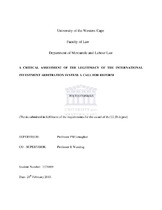| dc.contributor.advisor | Lenaghan, P.M. | |
| dc.contributor.advisor | Wandrag, R. | |
| dc.contributor.author | Cosmas, Julius | |
| dc.date.accessioned | 2015-08-18T09:29:11Z | |
| dc.date.available | 2015-08-18T09:29:11Z | |
| dc.date.issued | 2014 | |
| dc.identifier.uri | http://hdl.handle.net/11394/4389 | |
| dc.description | Doctor Legum - LLD | en_US |
| dc.description.abstract | Currently most international investment disputes are settled through arbitration. The origin of this dispute settlement system can be associated with the recent proliferation of over 3000 Bilateral Investment Treaties. Through this system disputes are settled by autonomous and differently constituted tribunals which have powers to render final and binding awards. The dissatisfied party has very limited opportunity to challenge the rendered award as there are no higher bodies in the hierarchy where a dissatisfied party can lodge an appeal, save for limited procedural challenges which are allowed under the system. These differently constituted tribunals at times reach diametrically opposed decisions on similar facts and those decisions stand side by side and all are considered valid. These inconsistent decisions are leading to lack of consistency and uniformity which in turn affects the legitimacy of the system as a whole. The rules of these institutions do not allow the proceedings to be held in public despite the fact that at times these tribunals question the regulatory powers of the state and state measures on service provision to its citizens. Another issue under the current system is that due to lack of coordination, arbitrators play dual roles: as counsels and arbitrators. This practice compromises the cherished principle of the rule of law. In the effort to address these concerns, stakeholders have suggested a number of possible solutions. The suggested solutions include: invoking res judicata and lis pendens principles; adopting the doctrine of precedent; applying the ‘fork in the road’ principle; adopting the margin of appreciation standard in interpretation of BITs; creating an appellate structure at ICSID and creating a treaty to treaty appellate body. This research submits that, the suggested solutions singularly and cumulatively don not address the legitimacy issues adequately. The research therefore calls for the establishment of a Multilateral Agreement on Investment (MAI) in order to address the legitimacy issues cumulatively. It is submitted that establishing a Multilateral Investment Agreement (MAI) which provides for creating a standing international investment court with an appellate court is the only solution which addresses all the issues haunting the international investment dispute settlement system. In addition, the research suggests interim solutions which will help to increase the legitimacy of the current system pending the establishment of the MAI and the courts. The interim solutions include: establishment of the investor – state dispute adjudication Centre; effective utilisation of host state courts; mandatory publication of all awards; enhancing the effective use of member states interpretative statement; and forming a working commission to provide basic interpretation and the scope of the basic international investment law principles. These measures are only meant to improve the current system pending the establishment of the MAI and the courts. The research concludes that for the betterment of international investment law, the reform is inevitable and that the benefits would outweigh any demerits. | en_US |
| dc.language.iso | en | en_US |
| dc.publisher | University of the Western Cape | en_US |
| dc.subject | International investment law | en_US |
| dc.subject | Bilateral investment treaty | en_US |
| dc.subject | Transparency | en_US |
| dc.subject | State arbitration | en_US |
| dc.subject | Investor | en_US |
| dc.title | A critical assessment of the legitimacy of the international investment arbitration system: a call for reform | en_US |
| dc.rights.holder | University of the Western Cape | en_US |

